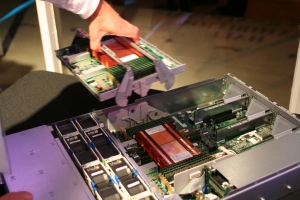Sun shows 2U 16-core Barcelona server with FSB1600


After last week's launch of Sun's 2U 16-core Intel Tigerton server last week, Sun followed up with an AMD Barcelona version last night at AMD's Barcelona launch. Sun kept the same compact 2U footprint while keeping all the features. So far, no other Server vendor has attempted to squeeze this many goodies in to a 2U chassis. Sun's CEO Jonathan Swartz talks about Sun's entrance in to the x86 world two years ago and the success they've had. Swartz announced the intention to take over 4th place in the x86 Server Market and these new 2U four-socket servers appear to be Sun's strategy to differentiate itself.
The new Barcelona four-socket server comes with dual TCP offloading enabled gigabit NIC cards, redundant power supplies, and 32 DIMM slots for up to 256 GBs of memory capacity (128 GB is more realistic now since 8 GB DIMMs are priced out of this world for now). In the image above, the hand is holding a tray with two Opteron quad-core servers and 16 DDR2 DIMMs. Below that tray are two more quad-core CPUs and 16 more DDR2 DIMMs. Half the memory and CPU are stacked on top of the other half and this is a rather unusual but innovative design.
What's notable about this system is that it's capable of running DDR2-667 or DDR2-800 though the 800MHz DDR2 DIMMs and the higher clocked Barcelona processors haven't launched yet. Due to the limitations of DDR2 memory, only the first half can be populated if maximum memory clock speeds are required. Once we go past 4 DDR2 DIMMs, the memory clock speed will drop down one notch. DDR2-667 memory will drop down to DDR2-533 and DDR2-800 memory will drop to DDR2-667.
Sitting in front the CPU and memory bank are two rows of redundant cooling fans which are hot-serviceable. You get an optical drive in the front along with 8 hot-swap SAS 2.5? hard drives that can be configured for up to RAID Level 6 though you’ll most likely want to configure it for four independent mirrored sets of RAID Level 1. Having all that redundant storage at your disposal means you can safely store the hard drive images for the 128 virtual guest machines you’ll be hosting on this virtualization monster. This could possibly be one of the fastest HPC servers in its class with DDR2-800 memory since AMD's processor architecture dominates on memory bandwidth.
The new AMD Barcelona processors have a new feature called "Rapid Virtualization Indexing" (nested paging) which improves Virtualization performance. AMD announced a 79% improvement on VMware's benchmark (beta version that supports nested paging) on the new Barcelona 2.0 GHz processor over existing Opteron dual-core 3.0 GHz processors. However, it's difficult to compare this to Intel since Intel claims a 167% improvement on the vConsolidate virtualization benchmark with Tigerton over previous generation Intel Tulsa four-socket servers. The benchmarks are different and the baselines are different and there's no way to tell which platform runs better until we can compare apples to apples. Both these benchmarks have been submitted to SPEC.org but it is very confusing at this time. I'll try to clear some of these questions up at VMworld tomorrow and in the coming weeks.